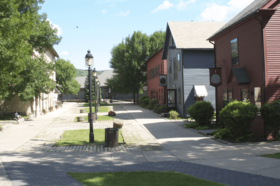Western Gateway Heritage State Park facts for kids
Quick facts for kids Western Gateway Heritage State Park |
|
|---|---|
 |
|
| Lua error in Module:Location_map at line 420: attempt to index field 'wikibase' (a nil value). | |
| Location | North Adams, Massachusetts, United States |
| Area | 8 acres (3.2 ha) |
| Administered by | Massachusetts Department of Conservation and Recreation |
|
Freight Yard Historic District
|
|
| Location | North Adams, Massachusetts |
| Built | 1859 |
| Architect | various |
| Architectural style | various |
| NRHP reference No. | 72000131 |
| Added to NRHP | June 13, 1972 |
Western Gateway Heritage State Park was a special place in North Adams, Massachusetts. It was a state park that focused on history. The park was managed by the Department of Conservation and Recreation.
This park was built in an old railyard. Its exhibits told the exciting story of the Hoosac Tunnel. The old freight yard itself was recognized as important history. It was added to the National Register of Historic Places in 1972. It was called the Freight Yard Historic District.
Contents
A Look Back: The Park's Story
North Adams and the Mountains
In the early 1800s, the city of North Adams was quite cut off. High mountains surrounded it. The Hoosac Mountain was to the east. The Taconic Mountains were to the west. This made it hard to travel to other parts of Massachusetts or New York.
The Coming of the Railroad
When railroads started to become popular in the late 1820s, people had new ideas. They wanted to build train tracks to connect North Adams. This would link the city to other places. The first train connection happened in 1846. It linked North Adams to Pittsfield in the south.
Building the Hoosac Tunnel
In 1848, a company called the Troy and Greenfield Railroad was formed. Their big plan was to build a train line. This line would go from Troy, New York, to Greenfield, Massachusetts. It would pass through North Adams. The most challenging part was digging a tunnel through Hoosac Mountain. This tunnel was called the Hoosac Tunnel.
Work on the Hoosac Tunnel began in the 1850s. It was a huge project. It took many years to finish. The tunnel was finally completed in the 1870s. Building it brought many jobs to North Adams. It helped the city grow a lot.
The Busy Rail Yard
Train service between North Adams and Troy started in 1859. This very rail yard was the end of the line on the eastern side. From 1859 until the Hoosac Tunnel opened in 1875, this yard was very busy. It served as a place for both cargo (freight) and passengers.
Later, around the year 1900, the main train activity moved. It went across the Hoosic River to a new station called Union Depot. But this old rail yard still played an important role. It continued to be used for handling and storing freight.
From Rail Yard to State Park
Over time, parts of the railroad land were updated. This happened in the second half of the 1900s. In the 1980s, people worked hard to save the old buildings. They fixed them up and turned some into a state park and museum. The park officially opened with big celebrations in the summer of 1986. It became a place where visitors could learn about the area's rich railroad history.

